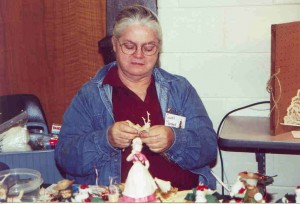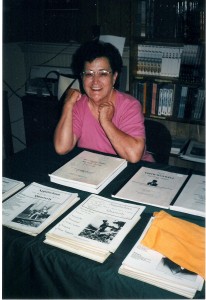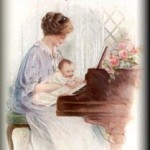RESEARCHING VIRGINIA RECORDS
By Rhonda Robertson
Many of our members have requested suggestions on how to do genealogical research in Virginia records. The following is an attempt to list the highlights of records that are available throughout Virginia.
Individuals using Virginia records are very fortunate, as few of the records dealing with Virginia citizens have been lost due to fire or other catastrophes. The majority of the records in the courthouses of all the 99 Virginia counties are virtually intact.
The first step in doing genealogical research is, of course, to talk with the oldest members of your family. They have, not only the factual knowledge of your history, but wonderful stories that add so much to your research and your understanding of those ancestors who are but dim photographs in ornate frames or photo albums.
Marriage Records
Marriage Bonds: From the earliest days of the Virginia colonies through 1853, individuals were required to obtain a marriage bond from the county of their residence. The concept of marriage bonds was derived from the old English custom of “publishing the banns”. The bond for a potential marriage was
posted by the father of either the bride or groom or some other close member of the family. The bond was $500, posted in either cash or property and was used to guarantee the forthcoming wedding. Virginia knew how to make money even then! Marriage Bonds are recorded from 1607 through 1853. Witnesses and individuals securing the bond are listed along with the prospective bride and groom, but no relationships to the couple are indicated. The date of the marriage bond is the date the bond was secured, not the date of the marriage. occasionally, a minister’s return is attached to the bond and if the bride or groom was underage, a “permission to marry” letter from the parents is also attached. Marriage Bond books and copies of the actual marriage bonds are on file in the Clerk’s Offices.
Marriage Licenses: in 1853, Virginia passed a law that Marriage Bonds would no longer be allowable to celebrate the rites of matrimony in Virginia. The new marriage license listed the names of the bridge and groom, their ages, sex, marital status, names of both sets of parents, the occupation of the groom, date the license was obtained, the place of residence and marriage and the
name of the minister. The requirement of all this additional information was a boon to genealogical research, providing a wealth of information in ‘register form. Also in the Clerk’s Office are the three-part Marriage Licenses. The names of the bride and groom are considered the first-part of the license. The second-part is the statistical information concerning the bride and groom. The third-part is the minister’s return, listing the date and place of the marriage and signed by him.
Land Records
From the formation of a county, through approximately the latter part of the 1800s, individuals recording land did so through a land entry-land survey process. In the 1700s there was no legal provision for the buying and selling of property through the recording of deeds. All property transactions were handled by land grant, land patent, bounty land warrant, Commissioner’s Certificate, etc.
Land was granted in large blocks, consisting of hundreds of thousands of acres, to land companies. In Southwest Virginia, land was granted primarily to the Loyal Land Company and the Ohio Land Company during the 1740s and 1750s. The companies sent surveyors and survey crews into this uncharted wilderness to survey and map their holdings. Maps were prepared by these surveyors and used by the company agents to sell land to the early settlers, site unseen. The company then issued a land patent to the purchaser. If the purchaser decided to sell the property, they merely wrote on the back of the patent to whom the property was transferred and the date of the transfer. Hence, property could be transferred many times between various individuals before it was actually ever entered officially into any record.
As counties were formed, individuals living in those counties were required to bring their patents, grants, etc. to the Courthouse and have them entered in the Land Entry Book. By entering your land you were requesting that the County Surveyor come and survey the property and enter it officially into the county records.
During the French and Indian War the English government granted large
blocks of land to soldiers in lieu of payment. Again, during the Revolutionary War, the newly established government of the United States could not afford to pay the majority of its soldiers, so land was granted for military service.
The award of land in acreage depended on the rank held by the soldier during the war. Normally, a private in the Revolutionary War received 400 acres. The location of the property was not specified on the land grant. The soldier could take the grant into any county and record 400 acres of unclaimed land.
Land Entry Books: Individuals living in the county at the time of its formation or moving into the county thereafter were required to record a Land Entry of their property. The source of the acquisition of the land was listed (grant, patent, etc.), the date of the acquisition, a description of the property. Unfortunately, many times the descriptions were only trees and rocks, but in many cases creeks, rivers and streams on which the property was located are mentioned.
Land Survey Books: After a land entry was recorded, a land survey was performed
by the County Surveyor, who was required to visit the property, record its most well known or visible boundaries. Many of the land surveys contains the names of neighboring property owners and other useful bits of information. The
callings given by the County Surveyor were sites and descriptions that would
have been well known to individuals living in the area during that time, but a mystery to those of us conducting research. The names of the neighboring property owners is of particular interest, as the early settlers tended to buy
their property and settle in groups as generally there was a physical relationship between these people. Early settlers, like many in our area today, tended to settle in groups of inter-related families. occasionally, property was recorded in the land entry books under one name, but the property was not surveyed in that same name. Either the individual withdrew the request and decided to record their entries elsewhere or the property was sold before the survey was completed.
Deeds: After the legal provisions for the recording of deeds was initiated, counties began to record the buying and selling of property. Deeds list the name of the buyer, the seller, and any other individuals involved in the transfer of property, and the date of the transfer. The callings or description of the property can again provide the location and immediate neighbors. occasionally, deeds can also be used to establish relationships between individuals. Many of the earliest settlers died without leaving wills so their property was automatically divided between their heirs. The property division was not recorded until the heirs sold their share of the estate.
Court Records
Wills: The Last Will and Testament and Estate Appraisals are recorded in county Will books. Wills give a concise picture of the property, both real and personal, owned by an individual as well as their bequests. Wills are excellent tools in proving familial relationships. Estate Appraisals and Sales of personal property are also recorded in the will books. Estate sales list the items of property owned by the individual, the debts owed and to whom. Items of the estate that were sold, list the amount the item brought and the buyer. Widows of the deceased could be left out of the will, if it was the desire of the husband. He could also dictate whether or not she could remarry. The normal procedure for remarriagebeing the forfeiture of her interest in her husband’s estate. Wills in Virginia are recorded beginning in 1607.
Court Orders: In counties where records have been destroyed by fire or other means, court orders can be used to establish numerous items. If deed books have been destroyed, the court order book list the order for the official recordation of deeds. The order for the recording of Wills are also to be found in the Court Order Books. The cost of building or remodeling the courthouse were recorded, the cost of food, lodging and drink were required for anyone requesting a tavern license. If an individual wanted to build a grist mill on their property, a notice had to be posted on the front of the courthouse with a hearing date to give anyone opposed to the license a chance to appear. The pay scale for officers of the court, the deputy sheriff and travel expenses were recorded. Individuals convicted of crimes were also listed along with their offense. Taxes, paid by individuals, in the form of road construction and maintenance were recorded.
Birth Records: Beginning in 1853, Virginia passed a law requiring the recordation of births within. any given county. The birth registers are on file in each clerk’s office beginning in 1853 and ending sometime in the late 1880s or early 1890s.
Births were again recorded beginning in June of 1912 through 1919 when they were required to be sent to the Bureau of Vital Statistics of the Health Department. The early birth registers contain the name of the child, date of birth, place of birth, name of father and mother, and father’s occupation. The name of the individual recording the birth and their relationship to the child is also listed.
Death Records: Death records, as with birth, were required to be recorded beginning in 1853 and continuing until the latter 1880s or early 1890s. There is a blankspace between 1890 and 1912 when no births or deaths were recorded. Deaths were again recorded beginning in June of 1912 and continuing through 1919. The death registers list the name of the deceased, place and date of death, cause of death, age, name of father and mother, and the recorder of the information.
Military Records
French and Indian War Service: No repository of records from the French and Indian War currently exists. only a few scattered records exist for the soldiers of that war. Most service information is found in the Court Order books of counties.
Revolutionary War: Soldiers and officers serving in the Revolutionary War, have military records on file in the National Archives in Washington, DC. In the early 1800s, Congress passed legislation that provided a pension for indigent soldiers who could prove service in the Revolutionary War. In each county of Virginia, former soldiers petitions for pension are on file. Those pensions are also included in a packet bearing that soldiers name in the National Archives.
Copies of these service records can be obtained from the National Archives or by visiting the county in which the petition was filed. The pension applications contain the date and place of birth of the soldier, the county and state in which he enlisted or was drafted and a detailed account of his military service, battles, etc. Whether or not pension was granted is also noted. These pension applications represent only a fraction of the soldiers that served. If a soldier was killed in battle or denied before the pension provision was enacted or if the former soldier was able to support himself, then no pension application is on file. Pensions for Revolutionary War service for widows was enacted a few years later. Detailed lists of military units and soldiers are on file in the National Archives. Recently, the military records and pension applications for the Revolutionary War have all been microfilmed and can be ordered from companies specializing in the renting of microfilm and sometimes through inter-library loan. Rolls of microfilm can also be purchased for private use directly from the National Archives.
War of 1812: Military records for the soldiers and sailors of the War of 1812 are also on file in the National Archives. Like the Revolutionary War, pension was again granted for indigent soldiers and are on file in the counties in which they resided at the time of application or the National Archives. These pension applications unfortunately are not as detailed as those of the Revolutionary War. The military records are microfilmed.
Civil War: Unlike previous wars, records from the Civil War are handled quite differently. Pension and military records for soldiers of the Union army and navy are on file at the National Archives in Washington, DC. Southern soldiers and sailors, on the other hand, are on file at the courthouses in each county were they resided. The South never surrendered the papers or documents pertaining to the military service of its soldiers. Pension applications for Union soldiers are printed on blue paper and applications for Southern soldiers are on gray paper. These pension applications contain a great deal of genealogical information from their birth place and date to their family history and the details of the military service.
Various Sources
Virginia Correspondence: Early records dealing with Southwest Virginia in the form of correspondence to the Governor and the House of D41egates are preserved in the multi-volume Calendar of Virginia State Papers and Henning’s Statutes at Large. Most of these records have been published in hard copy form and can be ordered through interlibrary loan.
Virginia State Library: An excellent source of genealogical and historical information. The Virginia State Library contains the collections of many of Virginia’s foremost genealogists and historians. Of particular interest to Southwest Virginia is the collection of Gordon Aronhime, formerly of Bristol.
The Virginia State Library has microfilm copies of all the court records from all the counties of Virginia: Wills, Deeds, Court Orders, Birth Registers, Death Registers, Miscellaneous papers, Marriage Registers, etc. Along with this collection are the correspondence between Virginia citizens and the House of Delegates. All this material can be accessed through inter-library loan.
Alderman Library: The University of Virginia contains the genealogical and historical material dealing with Southwest Virginia. The official repository for the records, and files of the W.P.A. project papers from the 1930s dealing with Southwest Virginia. Boxes and boxes of interviews with area residents are available for photocopying and research.
Virginia Genealogist: Published for over twenty years, an excellent source of unpublished material. Back issues are available on microfilm and current issues are available on microfilm or hard copy.
Virginia Magazine of History and Biography: No longer published, but an excellent source of early Virginia records and documents. Many of the items published inthis magazine were from private collections. A complete copy of the entire series can be found at the Virginia State Library.
College of William and Mary Quarterly: Still published by the College of William and Mary. wonderful source of Virginia information dealing mostly with the Eastern part of Virginia, with occasional mentions and items dealing with Southwest Virginia.
Census Records: Census records are available on microfilm beginning with 1790,the first census through 1920, which has recently been released. The census records for 1790 through 1840 contain only a minute amount of information. The name of the head of the household is listed, but only number of females and males are listed according to their age groups. Beginning in 1850, entire households were listed by name, age, place of birth and occupation. Notations were made as to physical disabilities on this census. As each new census was taken every ten years, more and more information was added until the 1920 census is an enormous volume of genealogical data.
Draper Manuscripts: A collection of letters written to Lyman C. Draper in the middle to latter 1800s from individuals who had lived in Southwest Virginia. These letters were solicited and compiled in conjunction with a history he was planning to write about Daniel Boone. These collected letters comprise approximately 50 rolls of microfilm belonging to the Wisconsin Historical Society.
Tax Records: Tax records for each county in Virginia are on file at the Virginia State Library. These contain only a minimal amount of information, normally listing only the name of the individual being taxed and the amount of their tax. A woman was only listed on the tax rolls for one year and that was the year of her widowhood.
County Petitions: on file at the Virginia State Library are county petitions filed with the Governor or House of Delegates. These petitions range from the formation of a county to the changing of county lines. Individuals signed their names to these petitions and the signatures are preserved on these original documents. Copies of these petitions can be obtained by writing to the Virginia State Library. During the early days of our country, many people were illiterate and there were people who made their living traveling from home to home and place to place, teaching individuals to sign their names to official documents.
THE MOST IMPORTANT ITEM TO REMEMBER – WHEN MAILING INQUIRIES AND REQUESTS TO ORGANIZATIONS AND INDIVIDUALS, ALWAYS SEND A STAMPED, SELF-ADDRESSED ENVELOPE!
You now have the basic tools to begin the search for your ancestors. The real reward of your search is the uncovering of bits and pieces of their lives and hints of their personalities. Through them we can participate in the founding and settlement of our country. So treasure each little of bit of information you find about them, no matter how seemingly insignificant, for it gives you just a little more insight into who they were and ultimately a glimpse into ourselves.







